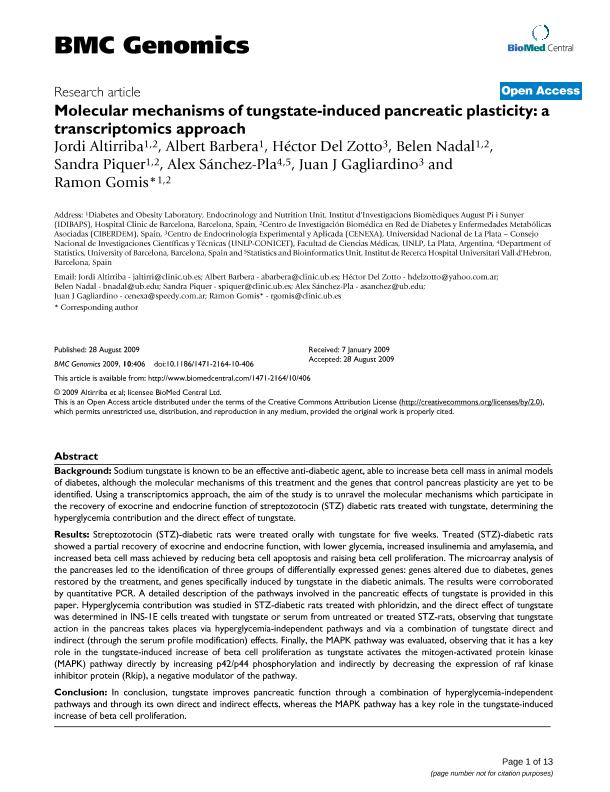Artículo
Molecular mechanisms of tungstate-induced pancreatic plasticity: A transcriptomics approach
Altirriba, Jordi; Barbera, Albert; del Zotto, Hector Herminio ; Nadal, Belen; Piquer, Sandra; Sánchez Pla, Alex; Gagliardino, Juan Jose
; Nadal, Belen; Piquer, Sandra; Sánchez Pla, Alex; Gagliardino, Juan Jose ; Gomis, Ramon
; Gomis, Ramon
 ; Nadal, Belen; Piquer, Sandra; Sánchez Pla, Alex; Gagliardino, Juan Jose
; Nadal, Belen; Piquer, Sandra; Sánchez Pla, Alex; Gagliardino, Juan Jose ; Gomis, Ramon
; Gomis, Ramon
Fecha de publicación:
08/2009
Editorial:
BioMed Central
Revista:
BMC Genomics
ISSN:
1471-2164
Idioma:
Inglés
Tipo de recurso:
Artículo publicado
Clasificación temática:
Resumen
Background: Sodium tungstate is known to be an effective anti-diabetic agent, able to increase beta cell mass in animal models of diabetes, although the molecular mechanisms of this treatment and the genes that control pancreas plasticity are yet to be identified. Using a transcriptomics approach, the aim of the study is to unravel the molecular mechanisms which participate in the recovery of exocrine and endocrine function of streptozotocin (STZ) diabetic rats treated with tungstate, determining the hyperglycemia contribution and the direct effect of tungstate. Results: Streptozotocin (STZ)-diabetic rats were treated orally with tungstate for five weeks. Treated (STZ)-diabetic rats showed a partial recovery of exocrine and endocrine function, with lower glycemia, increased insulinemia and amylasemia, and increased beta cell mass achieved by reducing beta cell apoptosis and raising beta cell proliferation. The microarray analysis of the pancreases led to the identification of three groups of differentially expressed genes: genes altered due to diabetes, genes restored by the treatment, and genes specifically induced by tungstate in the diabetic animals. The results were corroborated by quantitative PCR. A detailed description of the pathways involved in the pancreatic effects of tungstate is provided in this paper. Hyperglycemia contribution was studied in STZ-diabetic rats treated with phloridzin, and the direct effect of tungstate was determined in INS-1E cells treated with tungstate or serum from untreated or treated STZ-rats, observing that tungstate action in the pancreas takes places via hyperglycemia-independent pathways and via a combination of tungstate direct and indirect (through the serum profile modification) effects. Finally, the MAPK pathway was evaluated, observing that it has a key role in the tungstate-induced increase of beta cell proliferation as tungstate activates the mitogen-activated protein kinase (MAPK) pathway directly by increasing p42/p44 phosphorylation and indirectly by decreasing the expression of raf kinase inhibitor protein (Rkip), a negative modulator of the pathway. Conclusion: In conclusion, tungstate improves pancreatic function through a combination of hyperglycemia-independent pathways and through its own direct and indirect effects, whereas the MAPK pathway has a key role in the tungstate-induced increase of beta cell proliferation.
Palabras clave:
TUNGSTATO
,
CELULAS B
,
DIABETES
,
MASA DE CELULS B
Archivos asociados
Licencia
Identificadores
Colecciones
Articulos(CENEXA)
Articulos de CENTRO DE ENDOCRINOLOGIA EXP.Y APLICADA (I)
Articulos de CENTRO DE ENDOCRINOLOGIA EXP.Y APLICADA (I)
Citación
Altirriba, Jordi; Barbera, Albert; del Zotto, Hector Herminio; Nadal, Belen; Piquer, Sandra; et al.; Molecular mechanisms of tungstate-induced pancreatic plasticity: A transcriptomics approach; BioMed Central; BMC Genomics; 10; 1; 8-2009; 1-13
Compartir
Altmétricas



